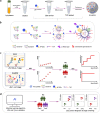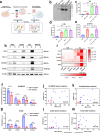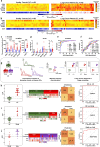Accurate and Convenient Lung Cancer Diagnosis through Detection of Extracellular Vesicle Membrane Proteins via Förster Resonance Energy Transfer
- PMID: 37643406
- PMCID: PMC10510723
- DOI: 10.1021/acs.nanolett.3c02193
Accurate and Convenient Lung Cancer Diagnosis through Detection of Extracellular Vesicle Membrane Proteins via Förster Resonance Energy Transfer
Abstract
Tumor-derived extracellular vesicles (EVs) are promising to monitor early stage cancer. Unfortunately, isolating and analyzing EVs from a patient's liquid biopsy are challenging. For this, we devised an EV membrane proteins detection system (EV-MPDS) based on Förster resonance energy transfer (FRET) signals between aptamer quantum dots and AIEgen dye, which eliminated the EV extraction and purification to conveniently diagnose lung cancer. In a cohort of 80 clinical samples, this system showed enhanced accuracy (100% versus 65%) and sensitivity (100% versus 55%) in cancer diagnosis as compared to the ELISA detection method. Improved accuracy of early screening (from 96.4% to 100%) was achieved by comprehensively profiling five biomarkers using a machine learning analysis system. FRET-based tumor EV-MPDS is thus an isolation-free, low-volume (1 μL), and highly accurate approach, providing the potential to aid lung cancer diagnosis and early screening.
Keywords: Förster resonance energy transfer; aptamer; extracellular vesicles; lung cancer diagnosis; membrane proteins.
Conflict of interest statement
The authors declare no competing financial interest.
Figures





References
-
- Pastorino U.; Silva M.; Sestini S.; Sabia F.; Boeri M.; Cantarutti A.; Sverzellati N.; Sozzi G.; Corrao G.; Marchianò A. Prolonged lung cancer screening reduced 10-year mortality in the MILD trial: new confirmation of lung cancer screening efficacy. Ann. Oncol 2019, 30 (7), 1162–1169. 10.1093/annonc/mdz117. - DOI - PMC - PubMed
-
- Xue Y.; Feng X.; Fan X.; Zhu G.; McLaughlan J.; Zhang W.; Chen X. Extracellular Vesicles for the Diagnosis of Cancers. Small Structures 2022, 3 (1), 2100096.10.1002/sstr.202100096. - DOI
Publication types
MeSH terms
Substances
LinkOut - more resources
Full Text Sources
Medical

